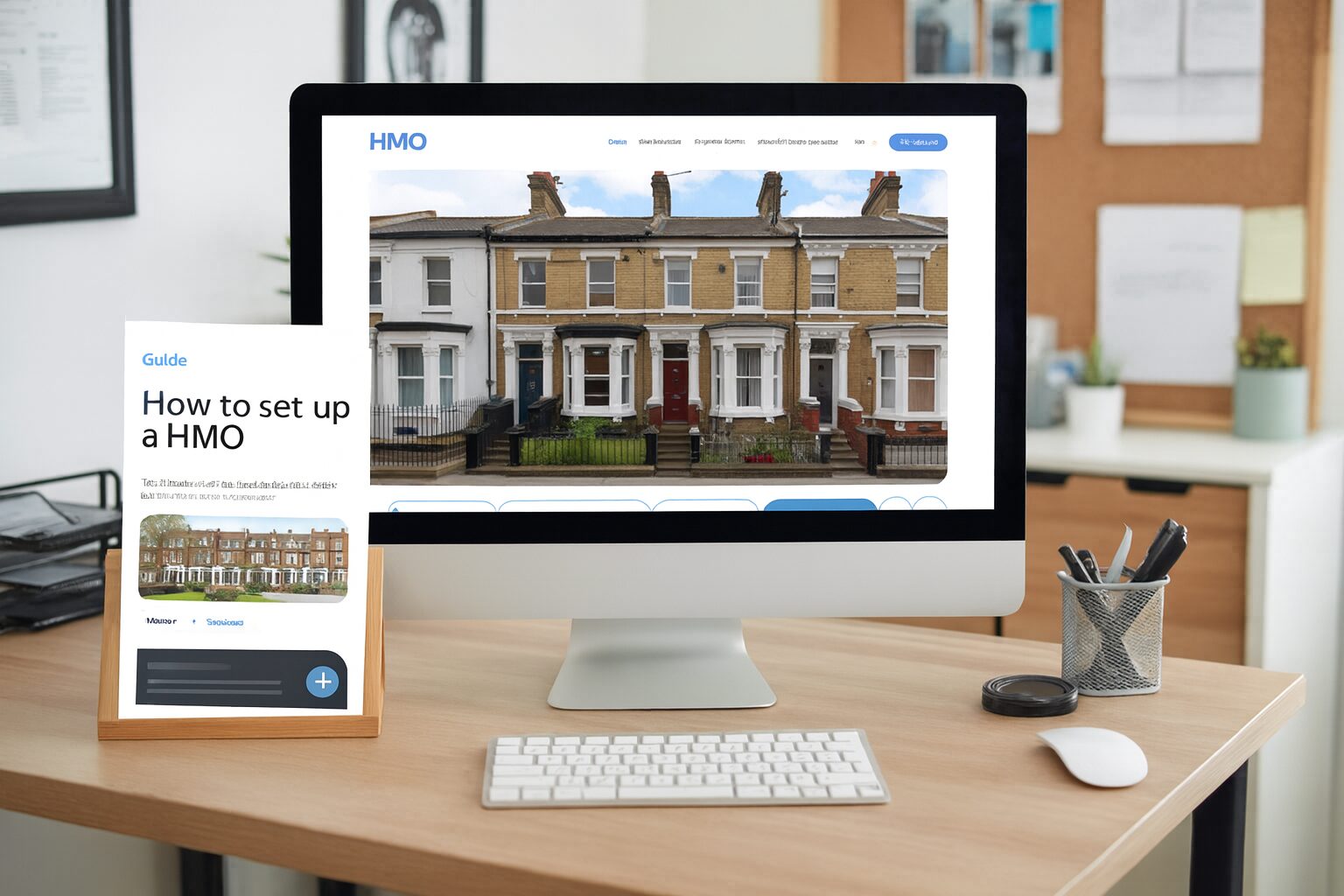
More and more landlords and developers are investing in houses in multiple occupation (HMOs). They like the superior rental yields they deliver and the jump in the resale value of residential properties when they’re converted to HMOs.
In this article, learn what the exact definition of HMO is under the law. Then, go through our step-by-step guide on how to set up an HMO and open your door to tenants.
What is an HMO? The legal definition
HMO stands for House in Multiple Occupation (HMO). The law classifies an HMO as a building (or part of one) occupied by three or more people forming more than one household. In most cases, they share one or more basic amenities such as a toilet, bathroom or kitchen.
What is a household?
A ‘household’ means a single person or members of the same family. This includes couples (unmarried, married, same-sex and civil partnership), half-, step- and foster-children.
For each household in an HMO property, this must be their only or main home. Full-time students are treated as occupying as their only or main residence during term time. But people renting short-term holiday cottages don’t.
Standard HMO rental property types
These are the four most typical types of HMO housing:
- Shared house: A property let to three or more people from two or more households who share basic amenities.
- Bedsits in a house: These are individual lockable rooms on separate contracts. Tenants share toilet, bathroom or kitchen facilities. They are not self-contained. If your tenants must leave their room to cook, bathe or use the toilet, it’s a bedsit/HMO setup.
- Single flat with sharers: More than two tenants (three or more people) who share basic amenities within the flat.
- Resident-landlord: A home with a resident landlord and up to two lodgers isn’t an HMO. With three or more lodgers, it is. For counting, the resident landlord and their household count together as one person.
Other types of HMO properties
There are HMOs where tenants don’t always share facilities. They include:
- Council-declared HMOs (section 255)
- Converted buildings that don’t entirely consist of self-contained flats
- Section 257 converted blocks of flats
We’re not covering them in this article because they are not the types of properties developers tend to focus on.
Adding an HMO to your property portfolio: “how-to”
Becoming an HMO landlord can be as straightforward as becoming a buy-to-let or holiday cottage landlord. Buy a property that’s in reasonably good shape, give it a cosmetic makeover and then rent the rooms out individually.
Some HMO landlords take a more complex route. They buy a tired or run-down property, invest a lot of money in remodelling it, eventually renting out to tenants months later when the work is complete.
Both approaches have merit. Below, discover our nine-step guide to becoming a licensed HMO landlord.
Step 1: set yourself a target
From the very start, be clear on exactly what it is you want to get out of your HMO property. There are two choices: flipping or renting out.
Some developers choose to flip. That involves buying an existing property and turning it into an HMO. Sometimes you’ll need planning permission for this and other times not. As an investment strategy, this makes sense.
According to Excellion Capital, HMOs in England sell for 13% more than the average house price. In some areas, it’s much higher: Newcastle 49%, Nottingham 45%, Liverpool 39%, Birmingham 36%, Bristol 30% and the list goes on. You could make a very generous immediate return with flipping.
That’s not the path most take though. Most hang onto their HMOs to rent out. Property Investments UK reports that the yield on HMOs is 10-15+% yield compared to 4-8% for standard buy-to-lets. In other words, you can make a lot more money a lot faster as an HMO landlord than a traditional landlord.
At the very start of your project, write down your goal in one paragraph. For example, that could be:
- “I want to buy a house and turn it into a 6-bed HMO. I want to make £2,000 per month from it. I have £175,000 to spend on the project. I will use £100,000 for a deposit, £50,000 for the build, £5,000 for a contingency and £20,000 on finance and other costs.”
That one-liner is your north star. Turn down any opportunity that doesn’t fit those criteria.
Step 2: planning essentials before you choose your route
The HMO planning process puts a lot of potential landlords off. In England, you usually don’t need planning permission to convert a standard home or flat (Use Class C3) into a small HMO (Use Class C4, 3–6 people). This is a “permitted development right” under GPDO 2015, Part 3, Class L. Different rules apply in the rest of the UK.
You DO need planning permission for setting up an HMO in these circumstances:
- Sui Generis HMO: This is for HMOs where seven or more tenants pay rent.
- Article 4 Direction: This is a power councils use to remove permitted development rights in specific locations, including a C3 to C4 conversion.
- Past planning conditions: Look for wording like “no development within Class L”.
Check that a property you want to convert is Use Class C3. For example, you might see a small care home (Use Class C2) and turn it into a six-bed HMO. Class L conversions don’t cover C2 to C4 conversions, so you’d need planning permission.
HMO Architects tip: New developers should choose a simple C3 to C4 conversion first. Lenders are less likely to back you the more complex the project. Get a few simple HMO conversions under your belt first before you go for a project with a grander scale.
Step 3: bring in a broker
You’ve got a better chance of getting the funding you need with a finance broker. Finance brokers have professional relationships with a variety of lenders (their ‘panel’). When someone applies to a broker for a loan, they approach the lenders on their panel most likely to approve the facility.
Finance brokers are very important to property developers. That’s especially true if this is your first HMO project. The three main benefits they offer are:
- Placement: They know where to place each loan proposal, saving you the time and hassle of finding lenders yourself.
- Packaging: Brokers present proposals to lenders “deal ready”. Each proposal has exactly the information and documentation a lender needs to proceed. This results in faster approvals.
- Promotions: Lenders get most of their business through brokers. To encourage them to push their products harder, lenders offer “broker-only deals” you couldn’t get by applying directly. This could save you a lot of money.
There are two rules of thumb to getting the most out of your broker:
- Don’t sugarcoat a deal – present the good and the bad
- Tell them exactly how much capital and experience you have on every deal
HMO conversion loan types brokers arrange
For HMO projects like those in this article, the three following types of finance will be suitable:
| Type of loan | Loan limited | Purpose |
| Light refurbishment bridging loan | Up to 65% of the property value and up to 100% build costs | Painting, decorating, replacing doors and windows, plumbing fixes and other light jobs |
| Heavy refurbishment bridging loan | Up to 65% of the property value and up to 100% build costs | Ideal for a house to HMO conversion or commercial to HMO planning use change. Used to fund structural changes, full kitchen and bathroom fits, large-scale external work and so on. |
| Development loan | Up to 70% of the gross development value or 90% of the property/land and build costs, whichever is the lower | Developers use these loans to fund new build HMO developments, major change of use work, substantial conversions and so on. |
What to ask for from your broker
Before you even start searching, share your written one-paragraph goal with your broker.
Ask them to secure you an agreement in principle (AIP) on those terms if possible. This will confirm the type of job a lender will back you up on and how much you can borrow.
AIPs are also very handy when you’re buying the property as we’ll cover later.
Step 4: choose your target market
Choose a target tenant for your HMO. Put yourself in their shoes to try to understand where they want to live and what they want in their living space. The closer your HMO is to those criteria, the easier it will be to let quickly and at the rent you expect.
Three popular target audiences are:
| Market | Wants | Benefits |
| Student accommodation | Within a 20-minute walk of the main university campus, the library and popular student nightlife spots.Good transport links are essential.Functional finishesNice communal area | 12 month lets every SeptemberVoids are rareAsk parents to act as guarantors |
| Young professionals | Higher standards than their student daysClose to major employment hubs, like business parks, hospitals and city centresGreat transport links near to gyms, supermarkets, bars and restaurantsSomewhere to park their carsBills-inclusive rent | More maturePay higher rentsLook after living spaces betterTend to stay for a long time |
| Contract workers | Suitable contractors want clean, functional, no-fuss accommodationOne- to three-month contractsExample: NHS workers want to be within a 15-minute walk from the hospital they’re seconded toExample: IT contractors want excellent access to motorways and A-roads. This is so they can reach clients on large corporate campuses in out-of-town business parks. | Competitive rentsSteady stream of demand so fewer voidsGet all the tenants you need by building long-term relationships with employers and recruiters |
Step 5: find the right property
Location is key. Rule out any areas where you can identify two or more reasons your target tenant wouldn’t want to live there. You need to load your bases from the start. Estate agents will be able to give you great advice.
When you find a potential property in those areas, ask yourself the following questions:
| Question | Checklist |
| Can you adapt the layout to meet HMO rules? | Measure individual rooms (bedrooms and communal areas) against your council’s minimum. Factor in the number of intended tenants to your calculation. Ensure there’s a protected escape route with fire doors. |
| Is there decent daylight and ventilation? | Assess that both the kitchen and bathroom extract to the outside. Bedrooms should also have an openable window with a decent view outside. |
| Where will bins and secure cycle storage go? | Look for enough space for a full set of council bins on the outside with a step-free route. You’ll also need a covered, lockable bike store that doesn’t go through the property’s living rooms. |
| How will the HMO affect local parking? | Off-street parking for your tenants would be ideal. If that’s not possible, consider local parking rules, the amount of on-street space and how busy it is after 6pm. |
Bringing your architect, HMO consultant, or an experienced builder with you to viewings is a smart idea.
At each viewing, ask them one question: “Can my plan work in this property within the target budget and standards?” Get their opinions on any structural changes and safety requirements like a fire-safety strategy. Sound them out on necessary upgrades to electrics, heating and hot water. Also, find out how long it might take to complete the work.
Be disciplined enough to walk away from any property that fails on size, layout, compliance or the basic project numbers.
HMO Architects tip: Whatever you do, don’t try to “design your way out” of problems. HMO minimum room sizes and standards on amenities and escape routes are hard limits. Retro-fitting properties, especially older ones, is very expensive and will eat into your return.
Step 6: purchasing the property
Shortlist the three or four properties that leave you the best margin after purchase, build and other costs. Ask your broker to run a quick desktop valuation on each property on the shortlist. This is a low-cost way of seeing if what your lender values a property at matches comparables and your estate agent’s opinion.
Apply the ceiling price test. On a street, the ‘ceiling price’ is the maximum someone would pay for a property. If the cost of a project (purchase plus build and other costs) exceeds the ‘ceiling price’, there are two choices. You can walk away or renegotiate to get the total cost at or below the ceiling price.
Negotiating to get the best price
Try to convince sellers their prices are too high by using comparables. Push the price down even further by sharing the likely cost of work to get the property to the standard you want. If you’re a professional builder, knock this off the asking price: retention will scare especially private sellers off.
Agree a price but make your offer subject to:
- Surveys (drains CCTV, asbestos, EICR and gas checks)
- Planning due diligence (Article 4 Direction check, any “C3 only” decision notice, confirmation of lawful use)
- Compliance (checks on room sizes and amenities)
If there are any nasty surprises and hidden problems, this gives you space to walk away.
Going ahead with the purchase
When you’re happy to proceed:
- Get your broker to finalise the loan to purchase the property
- Work out a drawdown schedule for build costs with the lender’s monitoring surveyor (your broker will help you)
- Instruct your solicitor to run local authority, environmental and water & drainage searches
- Order a RICS survey to flush out surprises like roof defects before the exchange of contracts
- Arrange buildings insurance from exchange of contracts. Switch to landlord insurance (HMO insurance) before tenants move in.
If you don’t have to go through the planning process, you can now skip to step eight.
Step 7: getting ready for the planning process (if required)
If you’re changing a property from Class C3 to Class C4, you usually don’t need planning permission in England. That’s unless it’s in an Article 4 Direction area or a past planning condition removes Class L rights, and there’ll be no more than six tenants. You do still need to make sure the property passes all HMO space, amenity and fire-safety standards to get it through licensing, which we cover later.
If you’re changing the class to sui generis or your property is not C3 (like a care home), you will have to apply for planning permission.
This is what you’ll need in your application pack:
| Item | What to include | Why it helps |
| Property drawings | Include scaled drawings of the property now and after your renovations. Mark out where key amenities and facilities like escape route, secure cycle storage, bedroom and communal spaces are. | HMO teams can see the layout of the property and assess compliance for the number of tenants. |
| Design and Access Statement | This is an easy-to-read 2–4 page, plain English summary of your proposal. Include information of how the HMO will fit into the wider street, how you overcome access issues and why the HMO will be a safe and comfortable place to live. | Planning case officers are generally very busy and will appreciate the overview. |
| Amenities | Show how, when measured against the number of tenants, kitchen bathroom and toilet provision is enough. Give the sizes of each bedroom and communal areas to prove they meet your council’s HMO standards. | Answers “does it fit HMO standards?” directly. |
| Parking and bikes | Explain the local and on-site parking situation. Show how you’ll provide covered, lockable bike storage with enough spaces for every resident. | Addresses potential impacts of quality of life for neighbours and traffic. |
| Noise and smells | Show how you mitigate against pubs, venues and takeaways with upgraded extractors, a lobby door and acoustic glazing. | Tackles concerns about tenant amenity and comfort upfront |
| Management summary | Who manages the HMO, details for a 24/7 neighbour contact, weekly common-area cleaning, house rules on quiet hours | Councils see you will address the major issues they would otherwise have to deal with. |
Your council may approve your request subject to conditions. You might see in their reply text like “before you let out the property, install bin and cycle stores, fit acoustic measures and submit the final management plan.”
Remember tenants can’t move into your HMO until you meet all of these conditions.
HMO Architects tip: Keep and update a one-page tracker, showing who needs to resolve each task and ticking it off when done. This avoids last-minute scrambles and failed inspections.
Step 8: the build and sign-off
Now, you’re ready to carry out the build part of the project to get your HMO ready for market. Whether this is a light touch up or a more intensive renovation, here’s how to manage and oversee a successful build.
A note on Building Control: You’ll need Building Control approval if your works are “building work” or a material change of use. Turning a house into an HMO usually counts as a material change of use under Regulations 5 and 6 of the Building Regulations 2010 and is often treated as a building with ‘rooms for residential purposes’, so Parts B, E, G, H and L will typically apply (to the extent necessary). If you’re only doing light refreshes (paint, like-for-like kitchen units) with no structural changes and no notifiable electrics or gas, you may not require Building Control.
Professionals: Notifiable electrical work must be certified under Part P (for example, new circuits, consumer unit replacement, or work in a room with a bath/shower) (use a registered electrician or notify the council), and gas work must be done by a Gas Safe-registered engineer.
The kickoff meeting
Before the work starts, sit down with your builder and designer and agree on the following points:
- Legal roles: Under CDM 2015, where more than one contractor will work on the project, you need a Principal Designer (often your architect) and a Principal Contractor (your main builder). Check they have insurance and RAMS (risk/method statements).
- The final specs: Settle on your approach to fire safety measures. This includes an agreed escape route, FD30S door rating, alarm grade/coverage to BS 5839-6 and any emergency lighting.
For ventilation and hot water, make sure the extract vents air outside and the hot-water system is the right size. Confirm who designs electrics to BS 7671 and any new circuits/consumer unit you’ll install, if applicable. Finally, decide where the bins and the secure bike store will be. - Inspection “hold points”: This is when you pause the project to check progress so you miss nothing.
Typical stages include first-fix (pipes, wires and cables before walls and floors cover them up), insulation, fire-stopping (materials you use to seal gaps to stop fire spreading) and drainage. Take photos and keep them with your records. These stages should match your Building Control Inspection Service Plan (if applicable). - Site access and delivery zones: Mark out how your tradesmen and deliveries will get onto the site and where you store any materials. You also need to mark which routes must stay clear as fire escapes.
Provide on-site staff with toilets, washing, drinking water, and a rest area from day one. Only allow deliveries between set hours, and use a simple sign-in sheet so only authorised people enter. - How you’ll handle waste: Choose which registered waste carriers you’ll use and how to keep waste transfer notes for every load. Separate the materials on site and never burn them. You or your supplier will need to arrange council permits for skip use when they’re on the road.
- Party-wall issues: Check to see if your work falls under the Party Wall Act. The Party Wall Act is a law that protects shared walls and boundaries between properties.
Potential triggers include cutting into a shared wall, building on the boundary, or digging near a neighbour’s foundations. If these apply, serve the correct notices and get an agreement (award) in place before you start. - Permits you need: List which local permits you’ll need early. Typical permits include for skips and scaffolding/hoarding if you’re on the road. Others may include parking bay suspensions. Your contractor will apply for these most of the time but make sure you confirm who’s responsible.
- Building Control visits: Confirm whether local authority building control or a Registered Building Control Approver (RBCA) will attend. Write down which stages they’ll inspect and the evidence they’ll want, like photos or test sheets. Never cover work like pipes, wiring or insulation until Building Control has checked it.
- How you agree project changes: Agree who can approve changes and what you need to make a change like descriptions, drawings and cost/time estimates. Also, insist that no work starts on a change until you get the costs and timings confirmed in writing. Keep a log of all changes.
When the project is live
When work is underway, stick to these guidelines:
- Keep to the plan: Meet your builder once a week for a quick check up on progress. Create and then store a one-page update on what decisions you make, who’s doing what and when task deadlines are. Remember to record any changes to agreed plans.
- Prove hidden works: Take photos at agreed hold points before anything gets covered up by walls and flooring. This includes insulation, fire-stopping materials (like collars and fire-resistant mastic) and services (like pipes and cables). Store the photos with your drawings and test sheets so you can show Building Control work done.
- Use qualified trades: Only let Gas Safe engineers work on gas appliances, pipework and flues. Only allow competent electricians to BS 7671 to design and install electrical work. For the HMO fire alarm (BS 5839-6), use a competent firm and agree the category/grade and zones.
- Stay lender-ready for drawdowns: Try to keep your site milestones to when the lender’s inspector comes around to do their survey. To speed up payments, keep an evidence pack ready with dated photos, invoices and any changes to your schedule.
- Be a good neighbour: Work the hours you agreed, keep the street tidy and put up a contact number. Record any complaints or anti-social behaviour in a log, as some councils require this for licensing. If you expect very noisy work, apply to the council in advance for consent to agree hours and methods.
Project wrap-up
When the build is near complete, walk through the HMO and build a snag list. A snag list is a list of defects and incomplete items. Show them to the project manager and agree who fixes what and by when. When you’re happy, book the final Building Control inspection.
Collect the following paperwork:
- Building Control completion certificate
- Planning conditions discharged (for anything marked “before occupation”)
- Safety certificates (including a simple weekly test log template and an emergency-lighting test if you’ve got it)
- Fire-risk assessment (for the common areas with a short evacuation plan)
- Energy Performance Certificate (and warranties and manuals)
You also need to make a compliance pack with your proof of planning permission, Building Control certificate and safety certificates. It also needs to include log templates for the alarm and emergency lighting, meter photos and “as-built” drawings. Last, the manager contact notice for the wall and your HMO licence (from the next stage of the process).
When the property is safe and usable, confirm Practical Completion in writing. Pay the final bill but hold back the agreed retention (usually 2–5%) until the builder completes the end-of-defects snags.
Finally, close the account. Compare the costs suppliers quoted with the costs you actually paid, listing every change. Agree the final figure with the project manager to stop surprise invoices appearing later on.
Step 9: HMO licensing (if needed)
HMO licensing is the formal permission local authorities give you to run your property as a multi-let. Running an unlicensed HMO risks an unlimited fine on prosecution, civil penalties up to £30,000 and a Rent Repayment Order (RRO).
RROs allow tenants to claim back up to 12 months’ rent. If your tenant is in receipt of housing benefit of Universal Credit, the council can claim the rent back from you. You also can’t serve a valid Section 21 notice while a required HMO licence is missing (exceptions include a valid application or a temporary exemption).
HMO Architects tip: If you buy a property with an HMO licence, the licence doesn’t transfer to you. As the new owner, you must apply for a new licence.
Types of HMO licences
There are two types of HMO licences:
- Mandatory licensing: All HMOs with five or more tenants forming more than one household need an HMO licence.
- Additional licensing: Local councils can require smaller HMOs with only three or four tenants to obtain a licence.
You should apply for an HMO licence before the property is occupied as a licensable HMO. Rules vary between local authorities, so check with your local licensing team.
Who should go on the HMO licence
The person holding the HMO licence should have the authority and funding to keep the property compliant. This is usually the owner or a manager.
You can name a manager to deal with tenants, repairs and inspections. But if the licence is in your name, you stay legally responsible even if a manager runs things. If the agent holds the licence, the legal duty shifts to them, though you can still face action for non-compliance under wider HMO rules.
If you’re unsure, it’s safer to hold the licence yourself and name your agent as the manager.
The HMO licence application process
When you apply for an HMO licence, you need to give the council detailed information about the property, the people in charge and how you will manage it.
Along with your application form, there may be two fees to pay. Part A is for the application (whether your application is accepted or not) and Part B is a contribution for running the scheme. If your application fails, Part B is not payable.
Along with your application and payment, submit the following:
- Scaled floor plans: These show the size of rooms (bedroom and communal areas), amenities and escape routes.
- Amenity schedule: This sets out the number of kitchens and bathrooms you have for the number of tenants who will live in your HMO.
- Fire safety evidence: The council will want a fire-risk assessment for your common areas. They’ll also want to know the type of alarm you have and alarm zones as well as the fire doors and closers you use.
- Safety certificates: This includes your Gas Safety, EICR and fire alarm commissioning certificates.
- Management plan: This is essentially the same as the management summary in the planning permission stage.
The licence holder will also have to pass a “fit and proper person” test. If the licence holder has been found guilty of serious past criminal offences, the council will decline your application. Crimes that bar permission include fraud, dishonesty and breaches of landlord law or housing law.
Approval with licensing conditions
If the council approve your licence, it will list certain conditions you have to meet including:
- Maximum occupants and rooms
- Amenities you need to provide
- Fire safety standards
- Waste and management
- Inspection and record-keeping
Your licence will last up to five years. If a council has concerns about your application, they may grant a shorter time. You need to reapply for your licence before it expires. Don’t let it lapse.
You have to notify the council on any variations you wish to make to your licence. That could be a change of layout, altering your amenities, changing the manager/agent and selling the property.
HMO Architects tip: Even if you don’t require an HMO licence, the local authority can and will regularly inspect your property to make sure it complies with legal standards. They do this under the Housing Health and Safety Rating System (HHSRS). Potential sanctions include prohibition orders, emergency remedial action and fines.
HMO Architects: start with one HMO then build a portfolio
There are multiple ways developers and architects can invest in HMOs. They’re worth around 13% more than standard residential properties across much of the UK and their higher yields mean a greater passive income. Whichever route you take, there’s more opportunity to build long-term wealth than with buy-to-lets and holiday cottages.
HMO Architects has helped 750 property developers and investors maximise their portfolios with HMOs. We’re investor-architects: we create homes that tenants want to live in while maximising our clients return.
Take a look at some of our recent HMO success stories:
- Durward Street, London (5 units): We converted a C3 family home into a compliant five-bed C4 HMO with a layout that can flex back to single-dwelling use. We focused on smart re-planning and fast-to-deliver upgrades, resulting in a strong uplift in both value (£650,000 to £1.2m) and rent (£350pcm to £2,500).
- Norman Road, Portsmouth (7 units): We turned a terraced house into a standout 7-bed Sui Generis HMO, delivering interiors that renters love while keeping every room practical. The property value more than doubled from £350,000 to £750,000 and rent soared from £900pcm to £5,500.
- Grove Lane, Ipswich (7 units): We extended and upgraded a corner-plot home into a 7-bed HMO, maximising en-suite provision and solving a tricky loft conversion despite an existing roof slope. The value of the property rose from £250,000 to £450,000 and the rent tripled from £1,400pcm to £4,200.
Come to us for an end-to-end service include:
- Investment advice: Bespoke advice on portfolio launch and scaling from Ryan Windsor. Ryan has worked on over 2,200 projects throughout his career. He started building his own extensive property portfolio when he was 17. Ask him about our portfolio building service and joint venture opportunities.
- Feasibility study: An expert-led breakdown of your pre-buy and design options for HMOs and other investment properties for just £197+VAT. We can even produce comprehensive reports on the viability of your scheme.
- Planning permission experts: Work with the team whose experience has secured planning permission for our clients across 200 councils.
- Interior design and exterior planning: Our architects are among the UK’s most experienced in HMO development in the UK. Benefit from their knowledge and insights throughout your project.
- On-site management: We can act as your Building Regulations Principal Designer (where required) to keep your project compliant. on track and within budget.
View our range of development finance case studies to see how we’ve helped clients turn their ideas into sound investments. Read customer stories on HMO, flat, holiday let and housing projects.
Call our experienced team on 01223 776 997 or email us.
Frequently asked questions
Do you need a separate licence for each HMO?
You need a separate licence for each licensable HMO you own. It’s normally best to make yourself the licence holder (license holder) as you are the person who has the control, money and authority to bring an HMO up to compliance and keep it at that level. You can however appoint a managing agent to look after day-to-day issues.
What does national law say an HMO is?
Under UK law, an HMO is a property where three or more tenants from more than one household share facilities and live as their main home. It’s not an HMO if there is only one tenant or household in a property.
Mandatory HMO licensing applies when five or more people from more than one household live in a property in England. However, many councils have introduced more rules that require smaller HMOs to have a licence. Ask if your council has an “additional HMO licensing” scheme.
What are HMO requirements?
The legal requirements covering HMOs come from national housing laws and the HMO Management Regulations. HMO requirements are your council’s standards on space, amenities and fire safety. Building Regulations sit alongside both. Keep a simple file showing the evidence your property requires and that your property meets it. Ask local experts if anything is unclear.
What does electrical safety and fire safety mean in practice?
You must keep safe and maintain any electrical appliances and electrical equipment you supply to the property. You also need to install smoke alarms to the required category and grade for the size of HMO you own and keep a test log. Blocked escapes, overloaded circuits and missing alarms are unacceptable risks and will lead to a licence application or renewal failure.
How should I set up tenancy agreements for new tenants?
You can choose tenancy agreements for room-by-room lets (individual units) or a single joint agreement if, for example, a group of students want to rent the whole property.
How do rental income, rent paid and council tax work in HMOs?
You can set rental income by room, with rent paid monthly and bills included, or one joint rent for all of your tenants. In most shared houses, you pay council tax for the whole property.
Giovanni is a highly accomplished architect hailing from Siena, Italy. With an impressive career spanning multiple countries, he has gained extensive experience as a Lead Architect at Foster + Partners, where he worked on a number of iconic Apple stores, including the prestigious Champs-Élysées flagship Apple store in Paris. As the co-founder and principal architect of WindsorPatania Architects, Giovanni has leveraged his extensive experience to spearhead a range of innovative projects.




